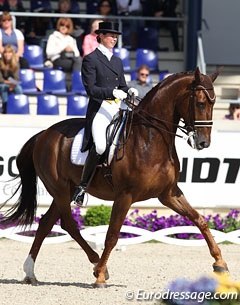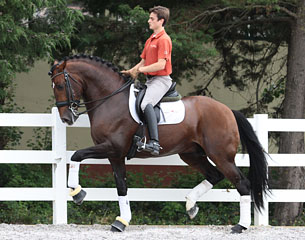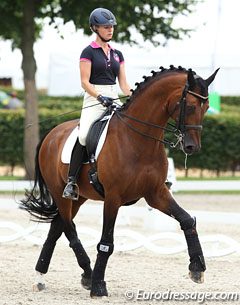
The half pass is another lateral movement that requires good balance and effective aids, but is also a lot to do with timing. "Don't begin a half pass if the horse is not energetic in his gait," Nuno Olivera stated. A half pass requires impulsion in the trot, in order for the horse not to get stuck and come off the contact, losing the engagement from behind and falling forward onto the shoulders.
"Begin the half pass with an impulsion that allows you to maintain the same cadence without slowing down or speeding up" N.Oliveira (1998, 71).
Once you have a trot that is both forward and rhythmic, you should ensure that your aids are not applied and left, but act to constantly keep the horses movement across and forward. A rider who can do a half pass, off a light touching leg, without the need to pull on the reins, has a horse in self carriage.
Beginning in a small circle, or coming out of shoulder-in, a rider must open up the inside shoulder, and with the outside leg slightly back, tap the horse with each stride to encourage both impulsion and lateral steps, simultaneously.
"One of the advantages of the half pass is to mobilize the haunches that have to push the mass" N.Oliveira (1998, 71).
By putting your leg back, you are better able to mobilize the horses haunches and thus use this power to generate greater length of stride right through to the front. It's also important to shift your weight to the inside, to help the horse move across, as many riders have a tendency to fall onto their outside seat-bone and try to push the horse across from the outside. Putting your weight to the inside not only opens up the angle of your inside hip, but also makes it easier for the horse to balance and maintain the bend. The outside rein should keep the most contact, and should act to control both the speed and the balance of the shoulders, by catching the horses power and channeling it in the curve of the horses half pass angle.
In the beginning, do not force the horse to quicken and go steeply sideways, but gently suggest the movement across a long diagonal, until he can gather the strength and ability to maintain the trot at a steeper sideways angle.
 "Riding a half pass does not mean rushing sideways, which would be a sort of defense, but it means to go supple-ly sideways" N.Oliveira (1998, 71).
"Riding a half pass does not mean rushing sideways, which would be a sort of defense, but it means to go supple-ly sideways" N.Oliveira (1998, 71).
If however your horse is sneaky using the circle of the corner to start the half pass may allow him the perfect escape. “If the horse is trying to cut the circle, or the corner, and cheat by leaving his quarters to the inside, or falling onto the shoulder, a more effective way is to begin the half pass as a leg yield,” says young trainer Joao Moreira. "Beginning at the start of the long side, put the horse in leg yield, off the outside leg, and keep the bend slightly to the outside to ensure the horse is really using himself and engaging his hind legs to step under and across. Then, once you have a forward active leg-yield, slowly shift the bend to the inside, while maintaining the impulsion."
"In the half pass you should feel that the outside hind leg is carrying the load forward" N.Oliveira (1998, 73).
“This way the horse will learn to flow forward into the half pass, and gain the gymnastic flexibility and strength that will enable him to commence it more easily from a vault or corner,” says Joao.
It is better for a rider to take time with the half pass, rather than force it, as Nuno reminds us that a gradually effective training method, is far better than a rushed disaster.
"It's difficult to improve a half pass. Success depends above all on the conditions under which the half pass was started" N.Oliveira (1998, 71).
Then once you have found your method for learning, you must always keep in mind; Don’t have too much bend or you block the inside shoulder. Feel that the outside hind leg is carrying the load forward. Control the rhythm and impulsion of the half pass with the outside rein. Bring your hip and your torso towards your inside elbow in the half pass, which will often replace the aid of the inside leg. Start the half pass with enough impulsion so you don’t need to drive continuously throughout the half pass. And remember:
“The inside leg is the most important one in the half pass. It receives the horse, maintains the bend, and, if necessary, the impulsion" N. Oliveira (1998, 75).
 Bend is one aspect that is often overlooked in the half pass, and i'm not talking about bend in the neck. "For a top half pass the horse must bend through his entire body in a curve of forward energy and impulsion," says training Joao Moreira. However, dressage training, is deeply driven by one movement's relationship with another, and it is so important to keep this in mind during the lateral work.
Bend is one aspect that is often overlooked in the half pass, and i'm not talking about bend in the neck. "For a top half pass the horse must bend through his entire body in a curve of forward energy and impulsion," says training Joao Moreira. However, dressage training, is deeply driven by one movement's relationship with another, and it is so important to keep this in mind during the lateral work.
"There is so much to say about shoulder in and half pass," says Dressage Technique expert Richard Weis. "There is only one movement in the shoulder in family and many in the half pass family i.e. renvers, travers, pirouette."
Richard says that shoulder in is moving away from the bend whereas and all other true lateral work (in the half pass family) exercises move towards bend. The two then, when used in unison, can help improve the success of the other. "In a way shoulder in is the antidote to all the half pass faults and visa versa," Weis explained.
Here is why. Bend allows the inside hind leg to step further under the weight of the torso (and rider). In shoulder in the inside hind leg not only steps under the weight of the body but it also lifts and propels the mass up the track. It strengthens the inside hind leg to ‘carry and push,' demanding in a very specific function. In the half pass the outside hind leg propels the mass of the body in the direction of travel. The inside hind leg receives and supports the mass of the body on bent joints (a similar strengthening action to levade). The inside hind is strengthened in its capacity to carry weight. The outside hind leg strengthens in its capacity to thrust or push. As soon as a half pass loses bend these entirely different demands for each hind leg are neutralized. Shoulder In can be used to reinstate bend and place the inside hind leg under the body again. Alternatively, in shoulder in, when bend is lost, a stride or two of half pass can be used to regain control of the quarters which have most likely swung out.
Richard explains there is great value in studying the three dimensionality of the left/right, front /back, top /bottom of lateral exercises, by focusing on the transition from half pass to shoulder in and shoulder in to half pass. "A good shoulder in will flow seamlessly to half pass and a good half pass will flow seamlessly to shoulder in, without the need for bend or positioning adjustments."
It is therefore important that we as riders not only use lateral work to strengthen, supple and engage our horses, but we also capitalize on the relationship between one lateral exercise to another.
by Sarah Warne for Eurodressage
Related Links
Classical Training: The shoulder in
Classical Training Articles by Sarah Warne